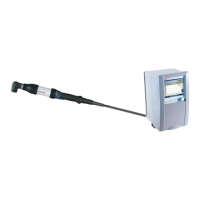3 608 878 300 Tightening Technology | Bosch Rexroth AG 335/641
System 350 | 3 608 878 300/2019-03
6.7.2 Configuring the OK/NOK counter for Open Protocol
If the OK/NOK counter value is set via MID 0019, the following settings can be made in the BS350 in
the OK/NOK counter configuration view if they are required for the sequence.
6.7.3 Diagnosis and troubleshooting
As of version V2.500 of the Rexroth Tightening System 350, the following options are available for
diagnosis:
• Detailed text protocol
This protocol can be accessed via BS350 under System test Diagnosis Open Protocol.
• Sequence trace
The sequence trace can be accessed via BS350 under System test ... FF3 or FF4.
• BS350 error list for system errors
6.7.4 Message structure
A message in the Rexroth OP has an ASCII format structure and consists of:
• Header (see Table 6–68)
• Data (see Tables 6–69, 6–70 and 6–71)
• End character (see Table 6–72)
The following table explains the message structure.
Table 6–67: OK/NOK counter configuration settings
Element Description
Counter records To be configured via MID 0019.
PLC signal selection No configuration required, setting not applied by Open Protocol.
Counting direction Can be configured.
Procedure if number of OK / NOK reached or for
abort
Can be configured.
Conditional blocking of the Loosen program Can be configured.
Job extension No configuration required, setting not applied by Open Protocol.
Special functions Can be configured.
Configuration of the OK/NOK counter can be started from various sources (BS350, Open Protocol, XML,
Job). This means that configurations made in the BS350 can be overwritten by XML, for example.
Table 6–68: Message structure in the Rexroth OP (header)
Header components Meaning Bytes
Message length Header length + data length
Value range: 0000 – 9999
Example:
4
Header length 20 bytes
Data length 37 bytes
Value 0057
MID (message ID) Describes how the sent message should be interpreted. Each
message ID is assigned to a specific message.
Value range: 0000 – 9999
Example:
4
Value 0002
Message Acknowledgement of communication start

